Royal
Free Hospital
(Liverpool Road Branch)
(Liverpool Road Branch)
Liverpool Road, Islington, N1 0YJ
Medical
dates:
Medical
character:
Infectious diseases. Later, obstetrics and gynaecology, paediatrics
In
1801 a group of citizens, including two physicians from the public
dispensary at Temple Bar, met at the Thatched House Tavern to discuss
means of dealing with the contagious diseases which were prevalent then
(social and hygienic conditions in London at that time were deplorable).
As a result of this meeting the Institution for the Care and Prevention of Contagious Fevers opend in 1802 at 2 Constitution Row, Grays Inn Lane, just north of Guilford Street. It was the first voluntary fever hospital and had 15 beds. It was staffed by a medical officer, three nurses, an apothecary and a porter. Admission depended on referral from a doctor, rather than a letter of recommendation from a lay subscriber.
The Institution dealt mainly with typhus cases, but patients with smallpox and scarlet fever were also treated. Despite protests and threats of legal action from local residents concerned with the spread of infection, the Institution survived and, during its first two years, had treated 550 patients. Like the London Smallpox Hospital established in 1746 in Windmill Street, its main purpose was to remove infected patients from the community. Patients' homes were also disinfected and fumigated, and the staff endeavoured to draw attention to the appalling housing and sanitary conditions prevailing at that time among the poor. (The Public Health Act of 1848 was the result of the agitation led by, among others, Dr. Southwood Smith, a staff physician).
In 1815 the Institution moved to the west wing of the Smallpox Hospital at Battle Bridge, where it had 60 beds (60 more were added later).
By 1842 about 1500 a year were admitted, mainly suffering from typhus and scarlet fever. Treatment was free if the patient had a subscriber's letter, otherwise the charge for treatment was 2 guineas (£2.10). Only servants and the 'decent poor' were admitted; wealthier patients were treated at home.
In 1848 the Great Northern Railway required the site for what is now Kings Cross station and the compensation money paid enabled the charity to build a new Hospital on Kettle Field, a 4-acre site in Liverpool Road, Islington. Once again, the local residents objected to a 'deadly pest-house' being built in their area but, in spite of their protests, the London Fever Hospital with 200 beds opened in 1849, and proved less of a hazard than feared.
When the Metropolitan Asylums Board was formed in 1867 to provide health care for paupers, the Hospital treated patients 'above the pauper class', servants of the upper classes and better-off people living alone. As with any other charitable institution at the time, financial crises were never far away. Voluntary support was difficult to find as the word 'fever' did not have the same emotional appeal as other afflictions and the patients, even if they survived, were not always good payers.
In 1897 several new blocks were built on the site, including an isolation block where patients were admitted until their diagnosis had been confirmed. The wards in the new buildings were fitted with electric lighting by each bed.
In 1908 four more general wards were added for female patients. The new block was opened by Lady Balfour of Burleigh, wife of Lord Balfour, the President of the Hospital.
In 1928 the Duchess of York (who later became Queen Elizabeth The Queen Mother) laid the foundation stone for a new extension.
In 1938 a new isolation block was opened by the Duke of Kent. The 3-storey building with 23 beds was so designed that each patient was isolated. Each compartment was separated by glass partitions so that the nursing staff could observe the length of the ward from the central kitchen. Curtains provided privacy when necessary. A wide verandah at the front of the building continued around both sides and formed a service corridor at the back. All nursing and other services were carried out from the open air; there were no internal corridors. Each patient had his own thermometer, torch, spatula, basin, treatment tray, and gowns for medical and nursing staff and visitors. All crockery was washed in the same sink in the central kitchen, then transferred in specially designed packs to be sterilized in a steam-jacketed tank. The new building had cost £30,000, of which £20,000 still had to be raised. The old isolation block, considered to be state-of-the-art when it had first been built, was converted into a private wing. The Hospital then had 209 beds, including 52 for TB patients. The local character of the Hospital had long disappeared and it now received patients from all over the country.
As public health and hygiene improved, infectious diseases became less of a threat, and the Hospital began to develop as a general hospital. Preventive inoculation against diphtheria gave a reasonable hope that the disease would be stamped out. Deaths from scarlet fever had become rare. Indeed, the mortality for measles was seven times higher than that for scarlet fever, but a preventive serum prepared at the Hospital from convalescent patients protected those who were inoculated with it.
During WW2 beds were allocated for casualties from bomb-damaged hospitals; the Royal Free Hospital was assigned 100 beds and the City of London Maternity Hospital 30.
In 1948 the Hospital joined the NHS as part of the Royal Free Hospital teaching group. It became known as the Royal Free Hospital Liverpool Road branch. It had 130 beds, mainly used for obstetrics and gynaecology, and for paediatric cases. It also had 23 private patient rooms.
The Hospital closed in 1975, when services transferred to the new Royal Free Hospital in Pond Street. The Liverpool Road Division in the new Hospital specializes in services for women and children.
As a result of this meeting the Institution for the Care and Prevention of Contagious Fevers opend in 1802 at 2 Constitution Row, Grays Inn Lane, just north of Guilford Street. It was the first voluntary fever hospital and had 15 beds. It was staffed by a medical officer, three nurses, an apothecary and a porter. Admission depended on referral from a doctor, rather than a letter of recommendation from a lay subscriber.
The Institution dealt mainly with typhus cases, but patients with smallpox and scarlet fever were also treated. Despite protests and threats of legal action from local residents concerned with the spread of infection, the Institution survived and, during its first two years, had treated 550 patients. Like the London Smallpox Hospital established in 1746 in Windmill Street, its main purpose was to remove infected patients from the community. Patients' homes were also disinfected and fumigated, and the staff endeavoured to draw attention to the appalling housing and sanitary conditions prevailing at that time among the poor. (The Public Health Act of 1848 was the result of the agitation led by, among others, Dr. Southwood Smith, a staff physician).
In 1815 the Institution moved to the west wing of the Smallpox Hospital at Battle Bridge, where it had 60 beds (60 more were added later).
By 1842 about 1500 a year were admitted, mainly suffering from typhus and scarlet fever. Treatment was free if the patient had a subscriber's letter, otherwise the charge for treatment was 2 guineas (£2.10). Only servants and the 'decent poor' were admitted; wealthier patients were treated at home.
In 1848 the Great Northern Railway required the site for what is now Kings Cross station and the compensation money paid enabled the charity to build a new Hospital on Kettle Field, a 4-acre site in Liverpool Road, Islington. Once again, the local residents objected to a 'deadly pest-house' being built in their area but, in spite of their protests, the London Fever Hospital with 200 beds opened in 1849, and proved less of a hazard than feared.
When the Metropolitan Asylums Board was formed in 1867 to provide health care for paupers, the Hospital treated patients 'above the pauper class', servants of the upper classes and better-off people living alone. As with any other charitable institution at the time, financial crises were never far away. Voluntary support was difficult to find as the word 'fever' did not have the same emotional appeal as other afflictions and the patients, even if they survived, were not always good payers.
In 1897 several new blocks were built on the site, including an isolation block where patients were admitted until their diagnosis had been confirmed. The wards in the new buildings were fitted with electric lighting by each bed.
In 1908 four more general wards were added for female patients. The new block was opened by Lady Balfour of Burleigh, wife of Lord Balfour, the President of the Hospital.
In 1928 the Duchess of York (who later became Queen Elizabeth The Queen Mother) laid the foundation stone for a new extension.
In 1938 a new isolation block was opened by the Duke of Kent. The 3-storey building with 23 beds was so designed that each patient was isolated. Each compartment was separated by glass partitions so that the nursing staff could observe the length of the ward from the central kitchen. Curtains provided privacy when necessary. A wide verandah at the front of the building continued around both sides and formed a service corridor at the back. All nursing and other services were carried out from the open air; there were no internal corridors. Each patient had his own thermometer, torch, spatula, basin, treatment tray, and gowns for medical and nursing staff and visitors. All crockery was washed in the same sink in the central kitchen, then transferred in specially designed packs to be sterilized in a steam-jacketed tank. The new building had cost £30,000, of which £20,000 still had to be raised. The old isolation block, considered to be state-of-the-art when it had first been built, was converted into a private wing. The Hospital then had 209 beds, including 52 for TB patients. The local character of the Hospital had long disappeared and it now received patients from all over the country.
As public health and hygiene improved, infectious diseases became less of a threat, and the Hospital began to develop as a general hospital. Preventive inoculation against diphtheria gave a reasonable hope that the disease would be stamped out. Deaths from scarlet fever had become rare. Indeed, the mortality for measles was seven times higher than that for scarlet fever, but a preventive serum prepared at the Hospital from convalescent patients protected those who were inoculated with it.
During WW2 beds were allocated for casualties from bomb-damaged hospitals; the Royal Free Hospital was assigned 100 beds and the City of London Maternity Hospital 30.
In 1948 the Hospital joined the NHS as part of the Royal Free Hospital teaching group. It became known as the Royal Free Hospital Liverpool Road branch. It had 130 beds, mainly used for obstetrics and gynaecology, and for paediatric cases. It also had 23 private patient rooms.
The Hospital closed in 1975, when services transferred to the new Royal Free Hospital in Pond Street. The Liverpool Road Division in the new Hospital specializes in services for women and children.
Present status (February
2008)
The Hospital building was managed by the Camden and Islington Area Health Authority and in 1980 became the temporary headquarters of the area's Community Health Council. It then stood empty until 1986 when the Circle 33 Housing Trust (now Circle Anglia) and the New Islington and Hackney Housing Association jointly bought it.
Each Association appointed their own architect - the western part of the site with the listed building went to Circle 33 and the eastern to New Islington and Hackney. Planning permission was granted in 1987 and building work began in 1989.
The site was converted into 178 flats and houses at the cost of £10m. It was one of the largest housing association projects undertaken. Four homes were specifically designed to accommodate wheelchair users. Sheltered accommodation was also provided.
A Psychiatric Rehabilitation Association Day Centre is located beside the former water tower, which has been converted into four flats.
The Hospital building was managed by the Camden and Islington Area Health Authority and in 1980 became the temporary headquarters of the area's Community Health Council. It then stood empty until 1986 when the Circle 33 Housing Trust (now Circle Anglia) and the New Islington and Hackney Housing Association jointly bought it.
Each Association appointed their own architect - the western part of the site with the listed building went to Circle 33 and the eastern to New Islington and Hackney. Planning permission was granted in 1987 and building work began in 1989.
The site was converted into 178 flats and houses at the cost of £10m. It was one of the largest housing association projects undertaken. Four homes were specifically designed to accommodate wheelchair users. Sheltered accommodation was also provided.
A Psychiatric Rehabilitation Association Day Centre is located beside the former water tower, which has been converted into four flats.
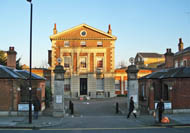
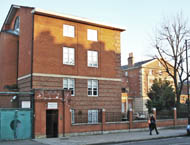
The housing development with new and converted Hospital buildings, as seen from Liverpool Road. The former administration building (left) bears the new legend 'Old Royal Free Place'. The gateways on Liverpool Road were made slightly wider to accommodate modern vehicles.
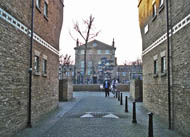
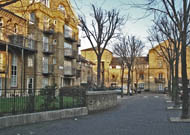
The view west from Southwood Smith Street (left) and inside the Square (right).
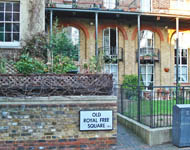
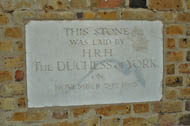
The street sign for Old Royal Free Hospital Square (left) outside Washington Court (half of the Old Royal Free Square's perimeter consists of new accommodation built within the shell of the Hospital buildings) and the foundation stone laid by the Duchess of York in 1928 (right).
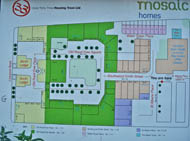
Site plan of the housing development.
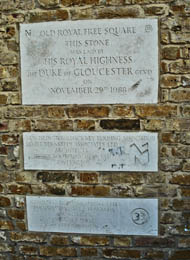
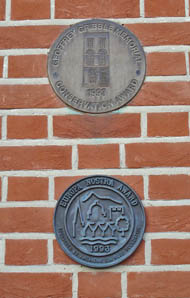
The 1988 cornerstones of the new development (left) and conservation award plaques (right).
Typhus and typhoid fever had not been distinguished until William Jenner (1815-1898) undertook a detailed study in 1844 of the cases of 'continued fever' at the Hospital. His published papers on the subject in 1849 and 1850 ensured that the error could not be maintained. Jenner was appointed a physician to the Hospital in 1853 and remained on the staff until 1861.
The writer Charles Dickens (1812-1870) was a supporter of various hospitals and in 1861 and 1862 he featured the London Fever Hospital in his magazine All the Year Round.
Amidon LA 1996 An Illustrated History of the Royal Free Hospital. London, Special Trustees of the Royal Free Hospital.
(Author unstated) 1938 London Fever Hospital. Opening of new block. British Medical Journal 191-192 (23 July).
Black N 2006 Walking London's Medical History. London, Royal Society of Medicine Press.
http://hansard.millbanksystems.com (1896)
http://hansard.millbanksystems.com (1975)
http://images.wellcome.ac.uk
www.aim25.org.uk
www.british-history.ac.uk
www.experiencefestival.com (Accessed February 2008)
www.geograph.org.uk
www.history.ac.uk
www.islington.gov.uk
www.locallocalhistory.co.uk
www.nhshistory.net
www.oldtowns.co.uk
www.rcnarchive.rcn.org.uk
www.royalfree.org.uk
Return to home page